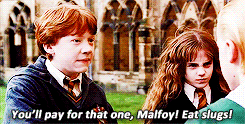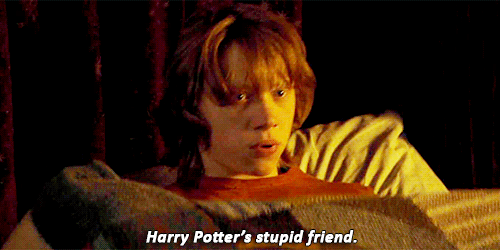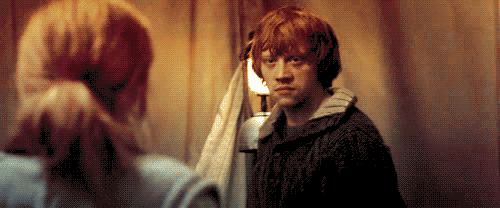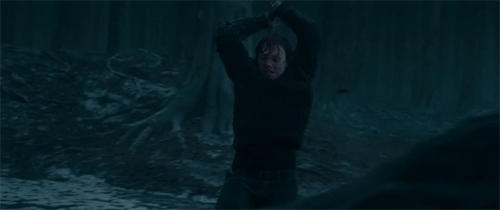Weasley Is Our Knight: Parallels Between Ron and Sir Gawain
Sir Gawain is probably familiar to most people as the protagonist of the Middle English poem Sir Gawain and the Green Knight. But Gawain features in many Arthurian texts and plays a particularly significant role in Sir Thomas Malory’s fifteenth-century Le Morte d’Arthur. Harry Potter has some clear Arthurian echoes – a magical sword that can only be obtained by those who prove themselves worthy, a wise wizard mentor, a young hero unaware of his origins, the role of prophecy – but Ron bears a striking resemblance to Gawain, who is not usually included in the conversation.
1. Family Ties
Both Ron and Gawain are strongly associated with their families, particularly brothers. Ron is easily identifiable as a Weasley, the youngest of six brothers, and Gawain is known as the head of the Orkney clan, the eldest of five brothers.
2. Conflicting Loyalties
Just as Ron is Harry’s best friend and a member of Dumbledore’s Army, Gawain is King Arthur’s nephew and one of the most prominent Knights of the Round Table. Ron is quick to defend his friends and is willing to put his life on the line for them: “If you want to kill Harry, you’ll have to kill us, too!” (PoA 339). Gawain follows his cousin into banishment from Arthur’s court. Tensions can arise between their allegiances to their families, friends, and fellowships. Percy pressures Ron to dump Harry, and Ron worries about his family while looking for Horcruxes with Harry. Gawain is torn between the duty he owes to Arthur as both kin and king and that he owes to his brothers, as well as to Sir Lancelot for often helping him.
3. Knighthood
Gawain is frequently recognized as one of Arthur’s best knights, known for his fearlessness and impressive military prowess across the land. The Sorting Hat places Ron in Gryffindor – the House of the brave, daring, and chivalrous – without a moment’s hesitation. Even at 12 years old, he proudly takes up the helm literally by playing as a knight in the life-size wizard chess game and nobly sacrifices himself so Harry can move on to save the Sorcerer’s Stone from Voldemort.
4. Temper
Passionate to the extreme, both Ron and Gawain have a tendency to lose their cool with both friends and foes. Ron attacks Malfoy on multiple occasions, usually in defense of his family and friends, but he can also have a short fuse with Harry and Hermione. Gawain has a penchant for violent vengeance, leading his youngest brother, Gareth, to distance himself.
5. Inadequacy and Envy
Ron and Gawain are both susceptible to strong feelings of jealousy. Gawain hates seeing other knights honored and is always outdone by Lancelot, to whom his brother Gareth clings rather than Gawain. He fails in the quest for the Holy Grail because he is too violent. Ron, living in the shadows of his older brothers and his famous best friend, struggles with self-esteem. He sees himself in the Mirror of Erised winning the type of glory his brothers have achieved and comes into conflict with Harry when Harry gets all the attention yet again as a Triwizard champion.
6. Abandonment and Betrayal
Gawain and Ron both end up hurting the people to whom they swore allegiance. Ron leaves Harry in his time of need during the search for Horcruxes, while Gawain pushes Arthur to pursue Gawain’s vendetta against Lancelot for accidentally killing his brothers, ultimately weakening the kingdom by dividing the Round Table, driving away many of Arthur’s knights, and leaving Camelot in Mordred’s untrustworthy hands.
7. Tests of Character
Ron redeems himself from the failings that destroy his predecessor. He escapes the tragic fate that befalls Gawain by balancing his loyalties, learning self-control, and confronting and overcoming his fears and insecurities. While Gawain fails to achieve the Holy Grail or pull a sword out of a stone, Ron obtains Gryffindor’s sword and destroys the locket Horcrux when it taunts him with his vulnerabilities. Ron sees the error of his ways and makes it his task to return to Harry’s side and aid him once again. Gawain has so many chances to turn back and give up on his losing battle against Lancelot that is hurting Camelot’s stability, but he continues desperately trying to prove himself as a knight and brother until his death. By the time he realizes what he has done and writes to Lancelot from his deathbed, asking him to come help Arthur fight Mordred, it is too late: Arthur dies and the kingdom crumbles before Lancelot returns.
Ron and Gawain are both incredibly complex characters who are often admirable but deeply flawed. Ron’s return reestablishes his status as a knight. By destroying the Horcrux, he destroys his own demons and returns to the quest completely devoted. He rejects the place he thought was assigned to him – secondary, insignificant, unloved – and takes the opportunity to be the hero he thought only Harry could be.










